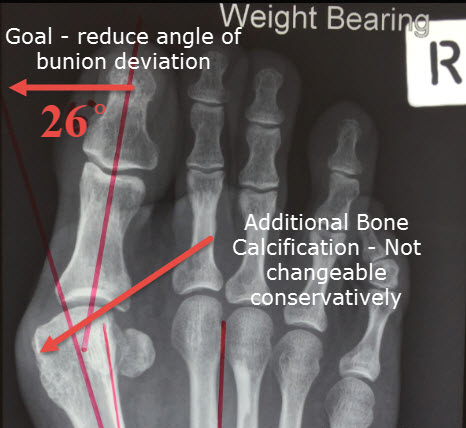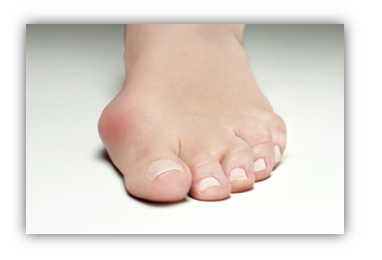What is a bunion?
A bunion is a bone deformity of the big toe and big toe joint. This is where the big toe shifts or deviates towards the outside of the foot. The technical name for a bunion is Hallux Abducto Valgus or Hallux Valgus.
A bulge or bony bump can develop on the inside of the big toe joint as the bunion develops. This typically increases in size over time.
The big toe joint can become reddened, swollen and painful and the joint cartilage can wear causing osteoarthritis.
Bunion Growth and Development
Bunions are a progressive big toe deformity. They tend to get worse over time. This means without treatment a bunion is more likely to grow and progress to the next stage. There are three stages of bunion development.
- Primary Stage (Mild): During the primary stage the big toe joint forms a slight bump and this is the beginning of a bunion.
- Secondary Stage (Moderate): As the bunion progresses the big toe starts to deviate towards the outside of the foot. This is where pain often begins.
- Tertiary Stage (Severe): At this stage the big toe has moved significantly towards the outside of the foot. The big toe is often overlapping or under-riding the second toe. This stage can be very painful and redness, swelling and a big bony bump will usually develop. This makes finding shoes that fit difficult.
What causes bunions?
Bunions are the result of foot biomechanical factors, genetics and footwear.
Feet that excessively roll in (pronate) can place extra pressure on the big toe during the toe push off phase of walking or running. When this happens every step, every day, it can push the big toe out of alignment over time.
Poor fitting footwear such as high heels and tight narrow shoes can increase the pressure on the big toe joint causing further deviation of the big toe.
A family history of bunions increases your likelihood of developing bunions because genetic characteristics can influence the joint shape and movement potential of the big toe joint.
Bunion Treatment?
Bunions do not get better on their own. In fact, when left untreated they generally progress and get worse.
Step 1 – Assessment and Diagnosis
The first step in treating bunions is to accurately assess your medical history and the stage and level of bony / arthritic change of the bunion.
Questions like: When did the bunion start? Is it painful and when? Do other family members have bunions? Do shoes make it worse? Help assess your situation. Taking the time to understand your problem here is vital to determining the best treatment recommendation for you.
The simplest and most accurate way to assess the stage of bunion development is via a weight-bearing x-ray of your foot.

The x-ray with show the degree of big toe deviation and the amount of bony growth at the side of the big toe joint. Comparing the x-ray results to clinical findings help formulate an appropriate treatment plan.
Step 2 – Restoring Normal Function
The main goal of treatment is to reduce pain, improve function and reduce the progression of the bunion deformity. Early treatment increases the likelihood of success.
Conservative treatment can involve Foot Mobilisation Therapy, Corrective Exercises and Orthotic Therapy.
Foot Mobilisation Therapy is performed to stimulate the body’s ability to repair and restore itself. Working on the joints helps to reduce pain and inflammation and restores foot mobility, function and posture. This is combined with Corrective Exercise to promote joint stabilisation, muscle strength and stretching.
These two treatment types work together, increasing your results.
Orthotic Therapy (shoe insoles) are sometimes used to further reduce over-pronation and excessive forces from the site of the bunion.
If your bunion development is severe and conservative treatment options have failed then surgical intervention may be indicated. Surgery is usually the last resort.
Step 3 – Preventing a Recurrence
Maintaining joint alignment, range of motion and surrounding soft tissue support is the key to preventing return of the bunion deformity and pain. This will require some simple self-care exercises and regular assessment of your feet to catch problems early.
Wearing sensible shoes and avoiding high heels (except for special occasions) will help protect the big toe joint.
Want to know more click here!
More blog posts…







No comments yet.